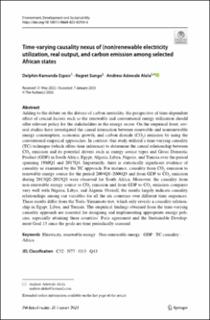| dc.description.abstract | Adding to the debate on the drivers of carbon neutrality, the perspective of time-dependent efect of crucial factors such as the renewable and conventional energy utilization should ofer relevant policy for the stakeholders in the energy sector. On the empirical front, several studies have investigated the causal interaction between renewable and nonrenewable energy consumption, economic growth, and carbon dioxide (CO2) emission by using the conventional empirical approaches. In contrast, this study utilized a time-varying causality (TC) technique (which ofers time inference) to determine the causal relationship between CO2 emission and its potential drivers such as energy source types and Gross Domestic Product (GDP) in South Africa, Egypt, Algeria, Libya, Nigeria, and Tunisia over the period spanning 1980Q1 and 2017Q4. Importantly, there is statistically signifcant evidence of causality as examined by the TC approach. For instance, causality from CO2 emission to renewable energy source for the period 2004Q1–2006Q3 and from GDP to CO2 emission during 2013Q2–2015Q3 were observed for South Africa. Moreover, the causality from non-renewable energy source to CO2 emission and from GDP to CO2 emission compares very well with Nigeria, Libya, and Algeria. Overall, the results largely indicate causality relationships among our variables for all the six countries over diferent time sequences. These results difer from the Toda–Yamamoto test, which only reveals a causality relationship in Egypt, Libya, and Tunisia.The empirical fndings obtained from the time-varying causality approach are essential for designing and implementing appropriate energy policies, especially attaining these countries’ Paris agreement and the Sustainable Development Goal 13 since the goals are time periodically assessed. | en_US |

